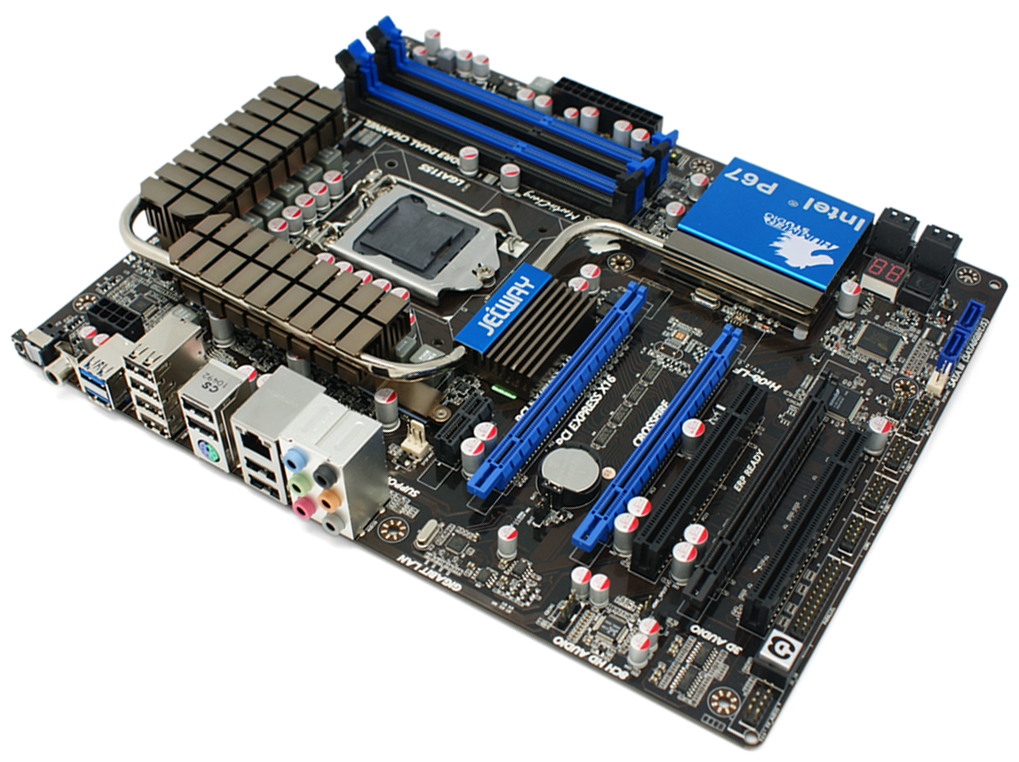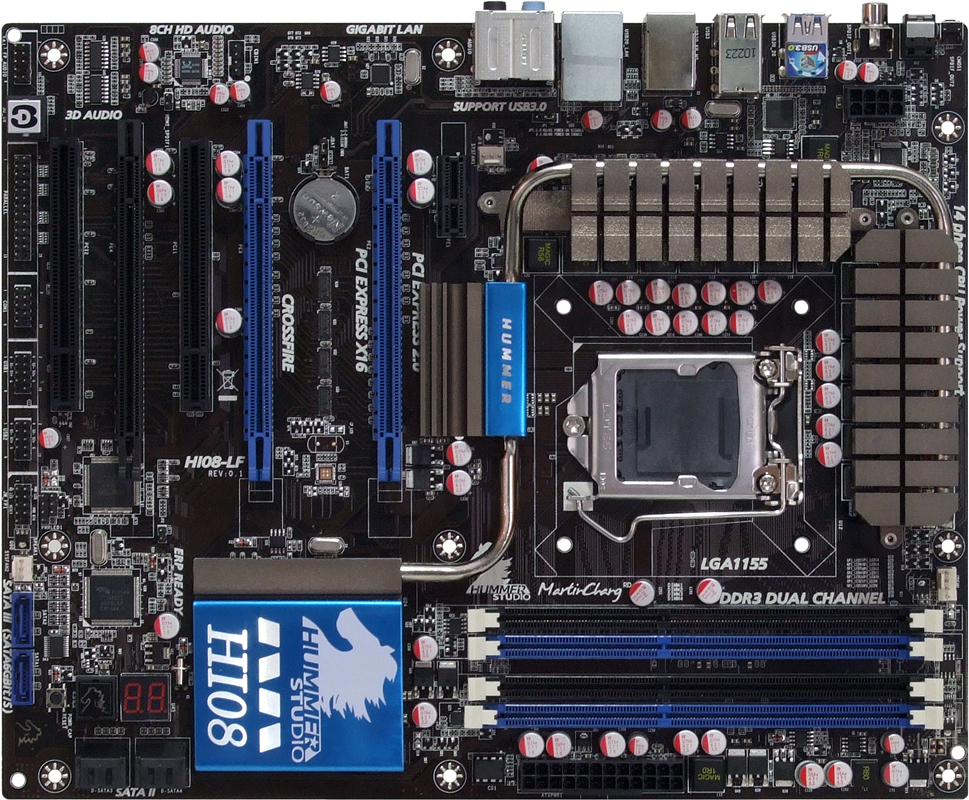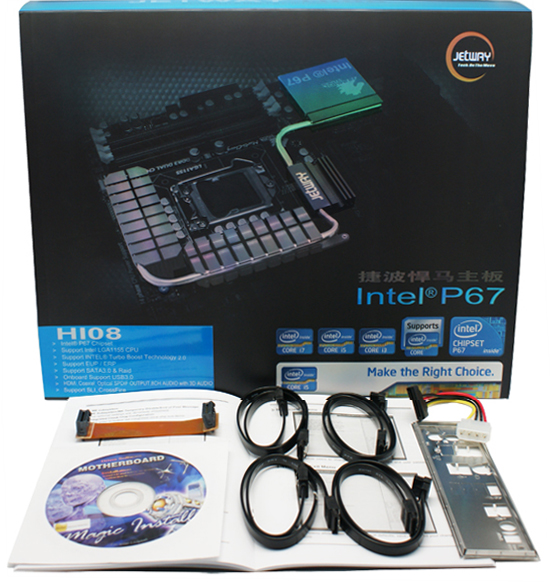P67 Motherboard Roundup: Nine $150-200 Boards
Improved per-clock performance and higher achievable frequencies are sure to put Intel’s latest K-Series CPUs on top of many builders’ whish lists, but they’ll still need a new socket to put it in. We test nine enthusiast-oriented LGA-1155 motherboards.
Jetway HI08
Jetway’s HI-series (officially named “Hummer Studio”) has continuously targeted the performance-value market, offering only those features that gaming enthusiasts want most at the lowest possible price. The HI08 continues that tradition by being the only board in today’s roundup that can hold three double-slot graphics cards within the confines of a standard seven-slot case.
There are still a few gamers out there that love their old PS/2 mice or “clicky” keyboards but far fewer that have both, so Jetway includes a single port on its I/O panel that can host either of these legacy peripherals. A “CLR_CMOS” button is also found in the upper corner to ease recovery from a failed overclock setting.
As with its triple-graphics competitors, the HI08 supports a single graphics card in x16 mode, two graphics cards in x8 mode, or three graphics cards in x8-x8-x4 modes, using automatic switching to shift lanes from the top to the second slot whenever a card in installed there. Yet, fitting all those double-slot cards into a standard case required Jetway to move the bottom slot upward by one position compared to ASRock and Asus. That move forced the middle slot upwards by one position, reducing the space between the top two cards from three slots to two. Reduced airflow to the top card is the price paid for making three cards fit within a standard case, since Jetway didn’t want to crowd the CPU cooler by moving its first x16 slot to the top position.
While we can appreciate Jetway’s design considerations, we would have preferred to see the eight-lane and four-lane x16 slots switched. That’s because an x8-x4-x8 configuration would have allowed extra cooling space in a two-card build. Crossed pathways, induced noise, and costly workarounds are Jetway’s most likely reasons for not implementing our preferred design.
Jetway places the P67 PCH’s two SATA 6Gb/s ports along the HI08’s bottom edge, far enough below the bottom x16-length slot to clear the coolers of most graphics cards. Our only real layout complaint is the bottom-rear corner position of its front-panel audio connector, since it requires a super-long audio cable with most cases. We were also surprised to find a parallel port next to it, though we can’t really complain about Jetway taking advantage of an interface that was freely available from the same I.C. that controls the PS/2 port.
Jetway sent us new images of its revised (retail) packaging and installation kit, including four SATA cables, a manual, an I/O shield, and an SLI bridge. CrossFire users will need to buy cards that include the bridge, but those cards are fairly common.
Get Tom's Hardware's best news and in-depth reviews, straight to your inbox.
-
reprotected I thought that the ECS looked pretty sick, and it did perform alright. But unfortunately, it wasn't the best.Reply -
rantsky You guys rock! Thanks for the review!Reply
I'm just missing benchmarks like SATA/USB speeds etc. Please Tom's get those numbers for us! -
rmse17 Thanks for the prompt review of the boards! I would like to see any differences in quality of audio and networking components. For example, what chipsets are used for Audio in each board, how that affects sound quality. Same thing for network, which chipset is used for networking, and bandwidth benchmarks. If you guys make part 2 to the review, it would be nice to see those features, as I think that would be one more way these boards would differentiate themselves.Reply -
VVV850 Would have been good to know the bios version for the tested motherboards. Sorry if I double posted.Reply -
flabbergasted I'm going for the ASrock because I can use my socket 775 aftermarket cooler with it.Reply -
stasdm Do not see any board worth spending money on.Reply
1. SLI "support". Do not understand why end-user has to pay for mythical SLI "sertification" (all latest Intel chips support SLI by definition) and a SLI bridge coming with the board (at least 75% of end users would never need one). The bridge should come with NVIDIA cards (same as with AMD ones). Also, in x8/x8 PCIe configuration nearly all NVIDIA cards (exept for low-end ones) will loose at least 12% productivity - with top cards that is about $100 spent for nothing (AMD cards would not see that difference). So, If those cards are coming as SLI-"sertified" they have to be, in the worst case, equipped by NVIDIA NF200 chip (though, I would not recommend to by cards with this PCIe v.1.1 bridge). As even NVIDIA GF110 cards really need less than 1GB/s bandwidth (all other NVIDIA and AMD - less than 0.8GB/s)and secondary cards in SLI/CrossFire use no more than 1/4 of that, a normal PCIe v.2.0 switch (costing less than thrown away with x8/x8 SLI money) will nicely support three "Graphics only" x16 slots, fully-functional x8 slot and will provide bandwidth enough to support one PCIe v.2.0 x4 (or 4 x x1) slot(s)/device(s).
2. Do not understand the author euphoria of mass use of Marvell "SATA 6G" chips. The PCIe x1 chip might not be "SATA 6G" by definision, as it woud newer be able to provide more than 470GB/s (which is far from the standard 600GB/s) - so, I'd recommend to denote tham as 3G+ or 6G-. As it is shown in the upper section, there is enough bandwidth for real 6G solution (PCIe x8 LSISAS 2008 or x4 LSISAS 2004). Yes, will be a bit more expensive, but do not see the reason to have a palliative solutions on $200+ mobos.
-
I was hoping that the new Asus Sabertooth P67 would be included. Its new design really is leaving people wondering if the change is as good as they claim.Reply



